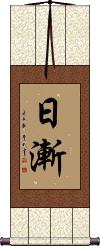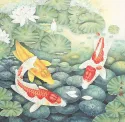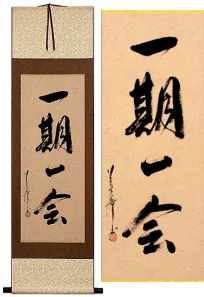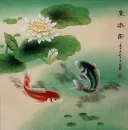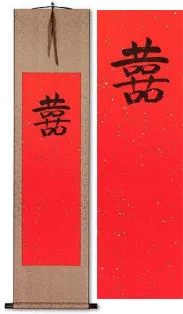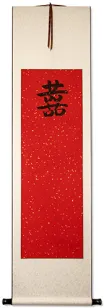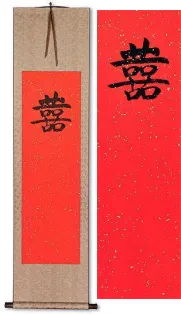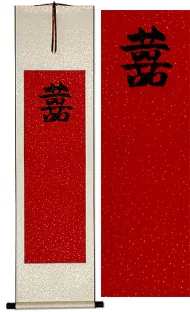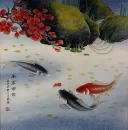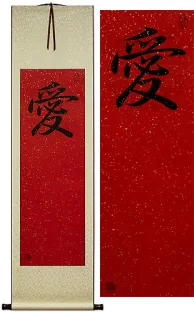Many custom options...
And formats...

One Day at the Time in Chinese / Japanese...
Buy an One Day at the Time calligraphy wall scroll here!
Personalize your custom “One Day at the Time” project by clicking the button next to your favorite “One Day at the Time” title below...
Progress Day by Day
One Good Deed Each Day
一日一善 is a Chinese, Japanese Kanji, and old Korean Hanja phrase that suggests doing a good deed each day or doing one good turn a day.
It literally reads, “One Day, One Good (Deed).”
One Day Seems Like 1000 Years
一日千秋 is a Japanese and Chinese proverb about missing someone.
一日千秋 is often used to express how hard it is to wait for someone's return or to be away from someone.
Some will translate this as “one day feels like a very long time” or “waiting for someone (something) is hard.”
You might see this romanized as a single word, Ichijitsusenshuu, or as “Ichijitsu Senshuu” from Japanese.
If you break down the characters one-by-one, we get:
一 = one/a
日 = day/sun (can also represent time or date)
千 = 1000/thousand
秋 = autumn/fall
Together, 千秋 can mean “autumn comes thousand times” (or 1000 years). It can also be read as 1000 periods of time.
However, it relays the idea of heartache as you wait for someone you miss.
This in-stock artwork might be what you are looking for, and ships right away...
Gallery Price: $90.00
Your Price: $49.88
Gallery Price: $340.00
Your Price: $188.77
Gallery Price: $61.00
Your Price: $33.88
Gallery Price: $61.00
Your Price: $33.88
Gallery Price: $61.00
Your Price: $33.88
Gallery Price: $61.00
Your Price: $33.88
Gallery Price: $304.00
Your Price: $168.88
Gallery Price: $90.00
Your Price: $49.88
Gallery Price: $90.00
Your Price: $49.88
Gallery Price: $90.00
Your Price: $49.88
Gallery Price: $90.00
Your Price: $49.88
Gallery Price: $304.00
Your Price: $168.88
Gallery Price: $90.00
Your Price: $49.88
Not the results for one day at the time that you were looking for?
Below are some entries from our dictionary that may match your one day at the time search...
| Characters If shown, 2nd row is Simp. Chinese |
Pronunciation Romanization |
Simple Dictionary Definition |
劫 see styles |
jié jie2 chieh kou; gou; kou / ko; go; ko こう; ごう; コウ |
to rob; to plunder; to seize by force; to coerce; calamity; abbr. for kalpa 劫波[jie2 bo1] (1) (こう, ごう only) {Buddh} kalpa (eon, aeon); (2) (kana only) {go} (usu. コウ) ko; position that allows for eternal capture and recapture of the same stones 刧 A kalpa, aeon, age; also translit. ka; 'a fabulous period of time, a day of Brahmā or 1, 000 Yugas, a period of four hundred and thirty-two million years of mortals, measuring the duration of the world; (a month of Brahmā is supposed to contain thirty such kalpas; according to the Mahābhārata twelve months of Brahmā constitute his year, and one hundred such years his lifetime; fifty years of Brahmā are supposed to have elapsed... ).' M. W. An aeon of incalculable time, therefore called a 大時節 great time-node. v. 劫波.; The three asaṃkhyeya kalpas, the three countless aeons, the period of a bodhisattva's development; also the past 莊嚴劫, the present 賢劫, and the future 星宿劫 kalpas. There are other groups. 三劫三千佛 The thousand Buddhas in each of the three kalpas. |
暇 see styles |
xiá xia2 hsia ka ひま |
leisure (noun or adjectival noun) (1) spare time; free time; leisure; (2) time (e.g. time it takes to do something); (noun or adjectival noun) (3) time off; day off; vacation; holiday; leave; (4) quitting (one's job); firing someone; divorcing (one's spouse); (adjectival noun) (5) (of one's time) free; (of one's business) slow; (noun or adjectival noun) (1) spare time; free time; leisure; (noun or adjectival noun) (2) time off; day off; vacation; holiday; leave; (3) quitting (one's job); firing someone; divorcing (one's spouse); (4) leaving; departing a leisure moment |
舎 see styles |
shè she4 she sha しゃ |
Japanese variant of 舍[she4] (suffix noun) (1) hut; house; (2) (abbreviation) (See 寄宿舎) boarding house; residence hall; dormitory; (3) (archaism) (in the ancient Chinese army) one day's march (approx. 12.2 km); (surname) Sha |
遑 see styles |
huáng huang2 huang itoma いとま |
leisure (noun or adjectival noun) (1) spare time; free time; leisure; (noun or adjectival noun) (2) time off; day off; vacation; holiday; leave; (3) quitting (one's job); firing someone; divorcing (one's spouse); (4) leaving; departing; (female given name) Itoma |
ヒマ see styles |
hima ヒマ |
(noun or adjectival noun) (1) spare time; free time; leisure; (2) time (e.g. time it takes to do something); (noun or adjectival noun) (3) time off; day off; vacation; holiday; leave; (4) quitting (one's job); firing someone; divorcing (one's spouse); (adjectival noun) (5) (of one's time) free; (of one's business) slow |
一日 see styles |
yī rì yi1 ri4 i jih hitoichi ひといち |
(n,adv) (1) (dated) one day; (adv,n) (2) (dated) all day (long); the whole day; (3) (poetic term) 1st day of the month; (place-name) Hitoichi A sun, or day from sunrise to sunset. |
一旦 see styles |
yī dàn yi1 dan4 i tan ittan いったん |
in case (something happens); if; once (something happens, then...); when; in a short time; in one day (adverb) (1) (kana only) once; (adverb) (2) (kana only) for a short time; briefly; temporarily; (3) (archaism) one morning; (place-name) Ittan once (something should happen...) |
或日 see styles |
aruhi あるひ |
(irregular okurigana usage) (n,exp) one day (e.g. "one day while studying, ..") |
時分 时分 see styles |
shí fēn shi2 fen1 shih fen jibun じぶん |
time; period during the day; one of the 12 two-hour periods enumerated by the earthly branches 地支 (1) time; hour; season; (2) suitable time; opportunity; chance Time-division of the day, variously made in Buddhist works: (1) Three periods each of day and night. (2) Eight periods of day and night, each divided into four parts. (3) Twelve periods, each under its animal, as in China. (4) Thirty hours, sixty hours, of varying definition. |
時辰 时辰 see styles |
shí chen shi2 chen5 shih ch`en shih chen jishin じしん |
time; one of the 12 two-hour periods of the day time; hour |
有朝 see styles |
yǒu zhāo you3 zhao1 yu chao aria ありあ |
one day; sometime in the future (female given name) Aria |
舍利 see styles |
shè lì she4 li4 she li shari |
ashes after cremation; Buddhist relics (Sanskirt: sarira) (1) śārī, śārikā; a bird able to talk, intp. variously, but, M. W. says the mynah. Śārikā was the name of Śāriputra's mother, because her eyes were bright and clever like those of a mynah; there are other interpretation (2) śarīra(m). 設利羅 (or 室利羅); 實利; 攝 M004215 藍 Relics or ashes left after the cremation of a buddha or saint; placed in stupas and worhipped. The white represent bones; the black, hair; and the red, flesh. Also called dhātu-śarīra or dharma-śarīra. The body, a dead body. The body looked upon as dead by reason of obedience to the discipline, meditation, and wisdom. The Lotus Sutra and other sutras are counted as relics, Śākyamuni's relics are said to have amounted to 八斛四斗 84 pecks, for which Aśoka is reputed to have built in one day 84,000 stupas; but other figures are also given. śarīra is also intp. by grains of rice, etc., and by rice as food. |
ある日 see styles |
aruhi あるひ |
(n,exp) one day (e.g. "one day while studying, ..") |
一日佛 see styles |
yī rì fó yi1 ri4 fo2 i jih fo ichinichi butsu |
A one-day Buddha, i.e. he who lives a whole day purely. |
一日經 一日经 see styles |
yī rì jīng yi1 ri4 jing1 i jih ching ichinichi kyō |
A sūtra copied in one day (perhaps by many hands); also styled 頓寫. |
何時か see styles |
itsuka いつか |
(adverb) (kana only) sometime; someday; one day; some time or other; the other day; in due course; in time; (female given name) Itsuka |
或る日 see styles |
aruhi あるひ |
(n,exp) one day (e.g. "one day while studying, ..") |
涅槃相 see styles |
niè pán xiàng nie4 pan2 xiang4 nieh p`an hsiang nieh pan hsiang nehan sō |
The 8th sign of the Buddha, his entry into nirvāṇa, i.e. his death, after delivering 'in one day and night' the 大般涅槃經 Mahaparinirvāṇa Sūtra. |
週一日 see styles |
shuuichinichi / shuichinichi しゅういちにち |
(expression) one day a week |
一日一夜 see styles |
yī rì yī yè yi1 ri4 yi1 ye4 i jih i yeh ichinichiichiya / ichinichichiya いちにちいちや |
all day and night ahorātra. One day one night, a day and night, a division of time. |
一日千里 see styles |
yī rì qiān lǐ yi1 ri4 qian1 li3 i jih ch`ien li i jih chien li |
lit. one day, a thousand miles (idiom); rapid progress |
一暴十寒 see styles |
yī pù shí hán yi1 pu4 shi2 han2 i p`u shih han i pu shih han ichibakujikkan いちばくじっかん |
one day's sun, ten days' frost (idiom, from Mencius); fig. to work for a bit then skimp; sporadic effort; short attention span (expression) (1) (yoji) (from Mencius) bursts of exertion will fail to bear fruit if interrupted by long periods of idleness; (expression) (2) (yoji) strenuous efforts, unless sustained, are to no avail |
一曝十寒 see styles |
yī pù shí hán yi1 pu4 shi2 han2 i p`u shih han i pu shih han |
one day's sun, ten days' frost (idiom, from Mencius); fig. to work for a bit then skimp; sporadic effort; lack of sticking power; short attention span |
一朝一夕 see styles |
yī zhāo yī xī yi1 zhao1 yi1 xi1 i chao i hsi icchouisseki / icchoisseki いっちょういっせき |
lit. one morning and one evening (idiom); fig. in a short period of time; overnight (yoji) in a day; in a brief space of time |
八關齋戒 八关斋戒 see styles |
bā guān zhāi jiè ba1 guan1 zhai1 jie4 pa kuan chai chieh hakkan saikai |
eight precepts of a one day vow holder |
十日の菊 see styles |
tookanokiku とおかのきく |
(exp,n) (idiom) (See 重陽) something that comes too late and is useless; chrysanthemum blooming on the 10th (i.e. one day too late for the Chrysanthemum Festival) |
半日工作 see styles |
bàn rì gōng zuò ban4 ri4 gong1 zuo4 pan jih kung tso |
part-time work in which one works each day for a half-day, typically a morning or an afternoon |
度日如年 see styles |
dù rì rú nián du4 ri4 ru2 nian2 tu jih ju nien |
a day drags past like a year (idiom); time hangs heavy; time crawls when one is wretched |
明け暮れ see styles |
akekure あけくれ |
(n,adv) (1) morning and evening; daily routine; (vs,vi) (2) to spend all one's time doing; to do day in, day out; (adverb) (3) all the time; always; constantly; day and night |
有朝一日 see styles |
yǒu zhāo yī rì you3 zhao1 yi1 ri4 yu chao i jih |
one day; sometime in the future |
Click here for more one day at the time results from our dictionary
The following table may be helpful for those studying Chinese or Japanese...
| Title | Characters | Romaji (Romanized Japanese) | Various forms of Romanized Chinese | |
| Progress Day by Day | 日漸 日渐 | rì jiàn / ri4 jian4 / ri jian / rijian | jih chien / jihchien | |
| One Good Deed Each Day | 一日一善 | ichi nichi ichi zen ichinichiichizen | yī rì yī shàn yi1 ri4 yi1 shan4 yi ri yi shan yiriyishan | i jih i shan ijihishan |
| One Day Seems Like 1000 Years | 一日千秋 | ichi jitsu sen shuu ichijitsusenshuu ichi jitsu sen shu | yí rì qiān qiū yi2 ri4 qian1 qiu1 yi ri qian qiu yiriqianqiu | i jih ch`ien ch`iu ijihchienchiu i jih chien chiu |
| In some entries above you will see that characters have different versions above and below a line. In these cases, the characters above the line are Traditional Chinese, while the ones below are Simplified Chinese. | ||||
Successful Chinese Character and Japanese Kanji calligraphy searches within the last few hours...
